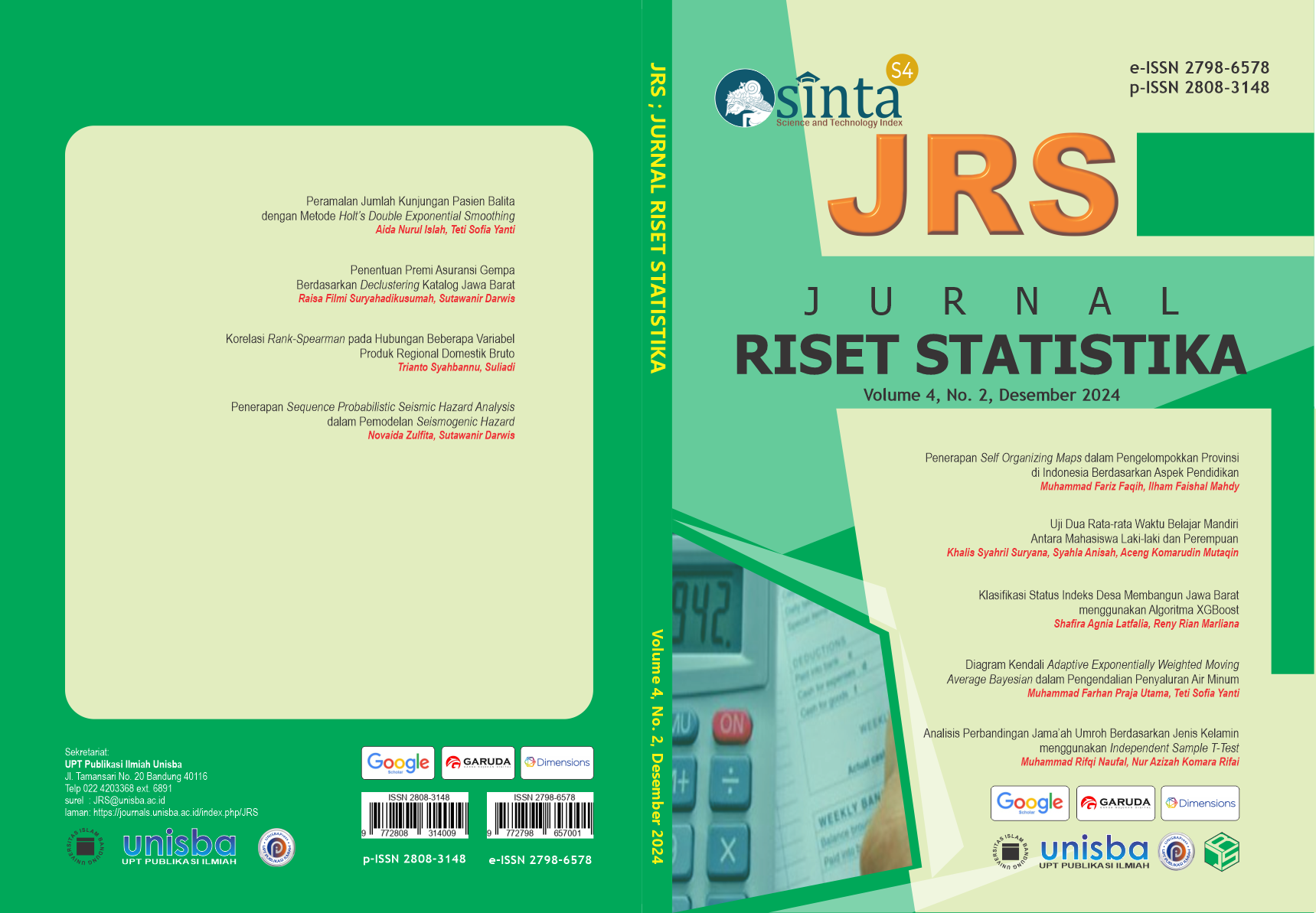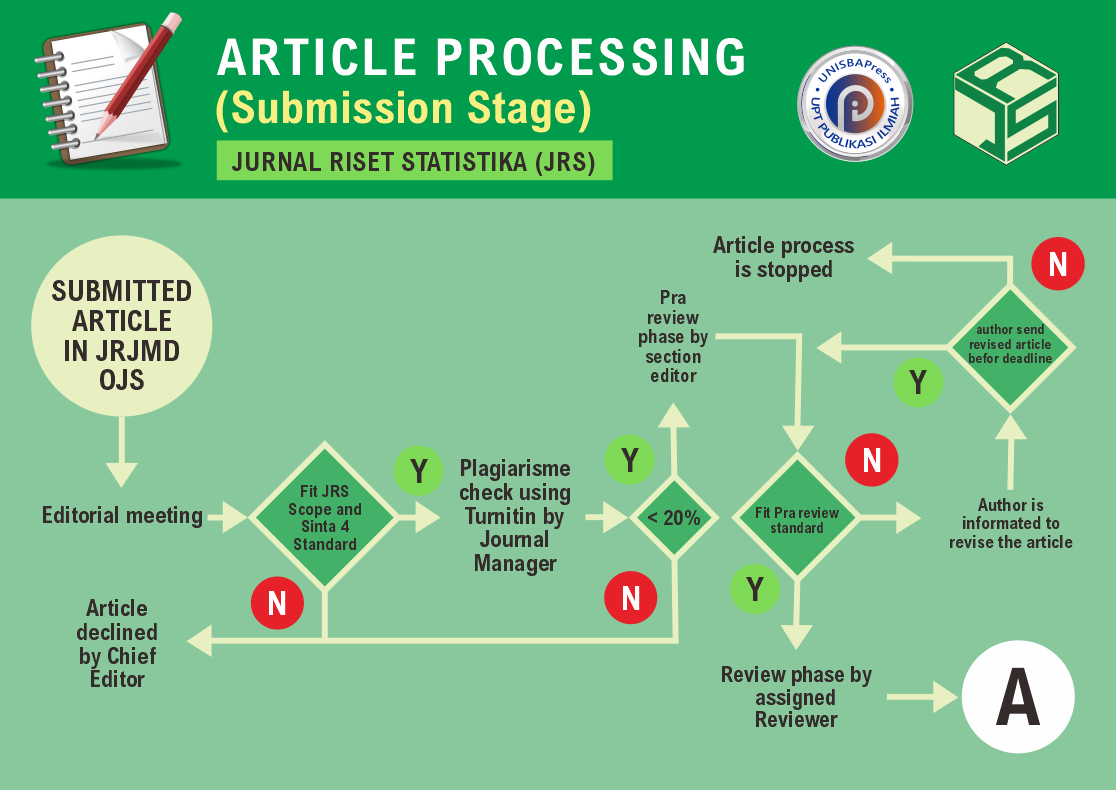Penerapan Sequence Probabilistic Seismic Hazard Analysis dalam Pemodelan Seismogenic Hazard
DOI:
https://doi.org/10.29313/jrs.v4i2.5163Keywords:
annual rate of exceedance, gempa utama, gempa susulanAbstract
Abstract. Seismogenic areas are areas in the earth's crust that have the potential to produce seismic waves due to tectonic activity. Identification of a seismogenic area measuring 30 x 100 km² with one main earthquake and eight aftershocks is the first step in earthquake risk analysis. Once identified, probabilistic modeling is used to estimate the frequency and magnitude of earthquakes. This modeling uses conditional probability and total probability to combine various earthquake sources, such as magnitude and distance, with data generated via Python software. The probability that the intensity of ground vibrations (Peak Ground Acceleration) will exceed the threshold within a certain period is calculated. This thesis integrates conditional and total probabilities from various earthquake scenarios to calculate the Sequence Probabilistic Seismic Hazard Analysis (SPSHA), which is a combination of main and aftershocks. This process begins with Probabilistic Seismic Hazard Analysis (PSHA) for the main earthquake, then Aftershock Probabilistic Seismic Hazard Analysis (APSHA) for aftershocks. The 1– m – a computational design includes configurations such as 1 – 1 – 0, 1 – 1 – 1, up to 1 – 1 – 8, where 1 represents the site, m the main earthquake, and a the aftershock. The discussion is limited to one and two dimensional spaces with a variety of geometric configurations. The analysis results show the important role of conditional probability in PSHA, APSHA, and SPSHA in seismogenic areas, where SPSHA provides a more realistic approach than PSHA by considering aftershocks that follow the main earthquake. This results in a higher annual rate of exceedance which is useful for earthquake risk analysis, disaster mitigation planning, and earthquake-resistant infrastructure design.
Abstrak. Seismogenic area adalah wilayah dalam kerak bumi yang berpotensi menghasilkan gelombang seismik akibat aktivitas tektonik. Identifikasi seismogenic area berukuran 30 x 100 km² dengan satu gempa utama dan delapan gempa susulan adalah langkah awal dalam analisis risiko gempa. Setelah diidentifikasi, pemodelan probabilistik digunakan untuk memperkirakan frekuensi dan magnitudo gempa. Pemodelan ini menggunakan peluang bersyarat dan peluang total untuk menggabungkan berbagai sumber gempa, seperti magnitudo dan jarak, dengan data yang dihasilkan melalui software Python. Probabilitas bahwa intensitas getaran tanah (Peak Ground Acceleration) akan melebihi ambang batas dalam periode tertentu dihitung. Skripsi ini mengintegrasikan peluang bersyarat dan total dari berbagai skenario gempa untuk menghitung Sequence Probabilistic Seismic Hazard Analysis (SPSHA), yang merupakan gabungan gempa utama dan susulan. Proses ini dimulai dengan Probabilistic Seismic Hazard Analysis (PSHA) untuk gempa utama, kemudian Aftershock Probabilistic Seismic Hazard Analysis (APSHA) untuk gempa susulan. Desain komputasi 1 – m – a meliputi konfigurasi seperti 1 – 1 – 0, 1 – 1 – 1, hingga 1 – 1 – 8, dimana 1 menyatakan site, m gempa utama, dan a gempa susulan. Pembahasan dibatasi pada ruang dimensi satu dan dua dengan variasi konfigurasi geometri. Hasil analisis menunjukkan peran penting peluang bersyarat dalam PSHA, APSHA, dan SPSHA di seismogenic area, dimana SPSHA memberikan pendekatan lebih realistis dibandingkan PSHA dengan mempertimbangkan gempa susulan yang mengikuti gempa utama. Ini menghasilkan annual rate of exceedance lebih tinggi yang berguna untuk analisis risiko gempa, perencanaan mitigasi bencana, dan desain infrastruktur tahan gempa.
References
R. E. Walpole and R. H. Myers, Probability & Statistics for Engineers & Scientists, Ninth edition. Boston: Pearson, 2012.
R. V Hogg, J. W. McKean, and A. T. Craig, Introduction to mathematical statistics, Eighth edition. Boston: Pearson, 2019.
T. Lay and T. C. Wallace, Modern global seismology. Academic Press, 1955.
C. A. Cornell, “Engineering seismic risk analysis,” Bulletin of the Seismological Society of America, vol. 58, no. 5, pp. 1583–1606, 1968.
S. L. Kramer, Geotechnical Earthquake Engineering. Prentice Hall, 1996.
I. Iervolino, M. Giorgio, and B. Polidoro, “Probabilistic seismic hazard analysis for seismic sequences,” Vienna Congress on Recent Advances in Earthquake Engineering and Structural Dynamics, no. 66, pp. 1–8, 2013.
G. L. Yeo and C. A. Cornell, “A probabilistic framework for quantification of aftershock ground‐motion hazard in California: Methodology and parametric study,” Earthq Eng Struct Dyn, vol. 38, no. 1, pp. 45–60, Jan. 2009, doi: 10.1002/eqe.840.
FERC Engineering Guidelines, Probabilistic Seismic Hazard Analysis, vol. 20. 2014.
A. F. Nurfauzan and S. Darwis, “Clustering Probabilistic Seismic Hazard Analysis Temporal Epidemic-Type Aftershock Sequence untuk Premi Asuransi,” Jurnal Riset Statistika, vol. 4, no. 1, pp. 41–48, 2024, doi: 10.29313/jrs.v4i1.3864.
J. W. Baker, B. A. Bradley, and P. J. Stafford, Seismic Hazard and Risk Analysis. Cambridge: Cambridge University Press, 2021.













